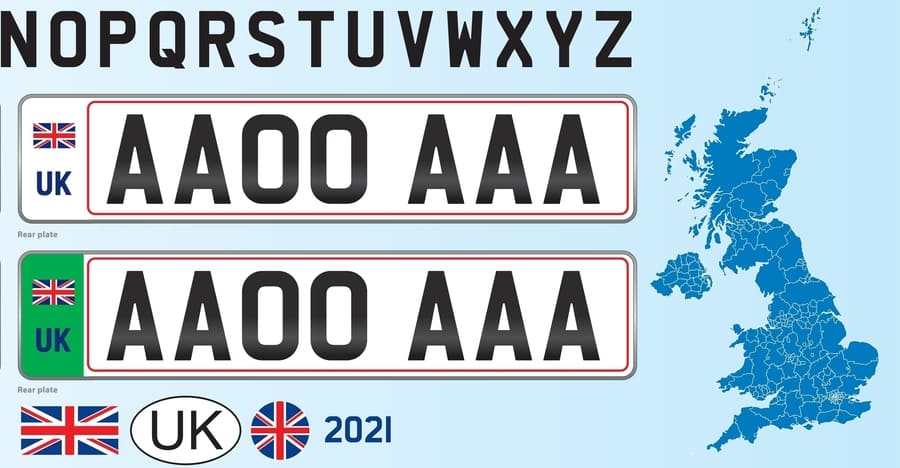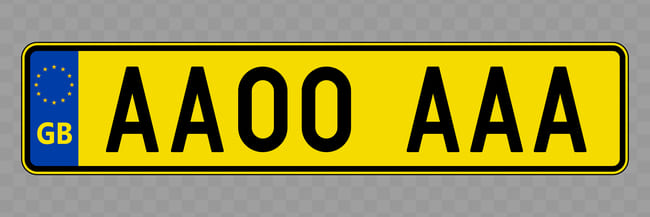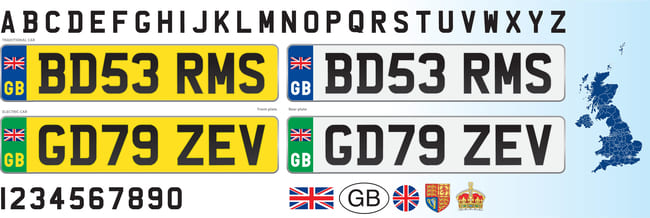
“What on earth do the numbers and letters on number plates mean?” – If you are reading this article, you have probably asked yourself the same question. Unless your plate is personalised, it may seem like a completely random combination, but the numbers and letters contain important information about your vehicle. Our handy guide will teach you how to read UK number plates.
How do UK registration plates work?

The current system for all standard licence plates has been in place since 2001. The UK number plate format can be divided into three parts: the local memory tag, the age identifier, and a unique combination of letters.
- The first two letters are the local memory tag, which shows where the vehicle registered.The first letter represents the region and the second one represents the DVLA local office. For example, plates with the letters BA to BY were registered within the Birmingham region.
- The age identifier is the two numbers that come after the local memory tag, indicating the age of the vehicle down to a six-month period – either from March to August or September to February. The identifier changes on 1 March and 1 September each year.
March codes are given according to the year of registration. For example, a car registered in 2019 would have ‘19’ on the number plate. For cars registered during the September-February period, the code is the year plus 50. So, for a car registered in 2003, this would be ‘53’.
- The last few letters that follow this code are randomly generated and allocated to a dealership when the vehicle is registered.
National flags on number plates

Since 2009, drivers across Great Britain have been able to display national flags on their number plate, including the Union Jack flag, Cross of St George, Saltire or Red Dragon of Wales.
You may also see one of the following identifiers: GB, Great Britain, GREAT BRITAIN, UNITED KINGDOM, United Kingdom, UK, CYMRU, Cymru, CYM, Cym, ENGLAND, England, ENG, Eng, SCOTLAND, Scotland, SCO, Sco, WALES or Wales.
Other flags and symbols are not permitted, however, you may still display the blue EU flag with the letters ‘GB’, for example. Since Brexit, drivers are required to display an oval ‘GB’ sticker when travelling through Europe.
What changed in March 2022?
The six month update means that any new vehicles registered from 1 March 2022 to 31 August 2022 will be given a “22” number plate. The new licence plates that are to be issued from September to February will have the number ‘72’ as the age identifier.
These registration plates will also incorporate the new changes that were introduced on 1 September 2021. The new design is made from more wear-resistant material and can be read by Automatic Number Plate Recognition (ANPR) cameras more easily.
What are the rules for UK number plates?
The new regulations state that all new plates must include the new mandatory font, however, existing plates don’t need to be changed as long as the font used is close enough to the new one. Any number plates that have been personalised with stylised letters and numbers or font altering plate fixing bolts must be replaced.
 @Newregcouk05.05.2023 07:30Member
@Newregcouk05.05.2023 07:30MemberWell, the UK number plate system is a fascinating subject, and I'm glad you asked about it! One small incident that comes to mind is when I was driving down a country road and noticed a car with a particularly unique number plate. It had a personalized registration that spelled out the owner's name in a clever way, and I couldn't help but admire the creativity and thought that went into it. It's just one example of how the UK's number plate system allows for personalization and self-expression, while still maintaining order and consistency on the roads.








Comments – 1